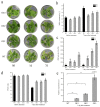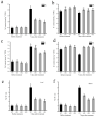A High-K+ Affinity Transporter (HKT) from Actinidia valvata Is Involved in Salt Tolerance in Kiwifruit
- PMID: 37958739
- PMCID: PMC10647804
- DOI: 10.3390/ijms242115737
A High-K+ Affinity Transporter (HKT) from Actinidia valvata Is Involved in Salt Tolerance in Kiwifruit
Abstract
Ion transport is crucial for salt tolerance in plants. Under salt stress, the high-affinity K+ transporter (HKT) family is mainly responsible for the long-distance transport of salt ions which help to reduce the deleterious effects of high concentrations of ions accumulated within plants. Kiwifruit is well known for its susceptibility to salt stress. Therefore, a current study was designed to decipher the molecular regulatory role of kiwifruit HKT members in the face of salt stress. The transcriptome data from Actinidia valvata revealed that salt stress significantly induced the expression of AvHKT1. A multiple sequence alignment analysis indicated that the AvHKT1 protein contains three conserved amino acid sites for the HKT family. According to subcellular localization analysis, the protein was primarily present in the cell membrane and nucleus. Additionally, we tested the AvHKT1 overexpression in 'Hongyang' kiwifruit, and the results showed that the transgenic lines exhibited less leaf damage and improved plant growth compared to the control plants. The transgenic lines displayed significantly higher SPAD and Fv/Fm values than the control plants. The MDA contents of transgenic lines were also lower than that of the control plants. Furthermore, the transgenic lines accumulated lower Na+ and K+ contents, proving this protein involvement in the transport of Na+ and K+ and classification as a type II HKT transporter. Further research showed that the peroxidase (POD) activity in the transgenic lines was significantly higher, indicating that the salt-induced overexpression of AvHKT1 also scavenged POD. The promoter of AvHKT1 contained phytohormone and abiotic stress-responsive cis-elements. In a nutshell, AvHKT1 improved kiwifruit tolerance to salinity by facilitating ion transport under salt stress conditions.
Keywords: A. valvata; HKT; ion transport; overexpression; salt tolerance.
Conflict of interest statement
The authors declare no conflict of interest.
Figures








Similar articles
-
Transcriptome-Wide Identification and Functional Characterization of CIPK Gene Family Members in Actinidia valvata under Salt Stress.Int J Mol Sci. 2023 Jan 2;24(1):805. doi: 10.3390/ijms24010805. Int J Mol Sci. 2023. PMID: 36614245 Free PMC article.
-
Genome-wide identification of kiwifruit K+ channel Shaker family members and their response to low-K+ stress.BMC Plant Biol. 2024 Sep 6;24(1):833. doi: 10.1186/s12870-024-05555-x. BMC Plant Biol. 2024. PMID: 39243055 Free PMC article.
-
Overexpression of high affinity K+ transporter from Nitraria sibirica enhanced salt tolerance of transgenic plants.Plant Sci. 2024 May;342:112052. doi: 10.1016/j.plantsci.2024.112052. Epub 2024 Feb 26. Plant Sci. 2024. PMID: 38417716
-
Ion homeostasis for salinity tolerance in plants: a molecular approach.Physiol Plant. 2021 Apr;171(4):578-594. doi: 10.1111/ppl.13185. Epub 2020 Aug 31. Physiol Plant. 2021. PMID: 32770745 Review.
-
Potassium and sodium transport in non-animal cells: the Trk/Ktr/HKT transporter family.Cell Mol Life Sci. 2010 Aug;67(15):2511-32. doi: 10.1007/s00018-010-0317-7. Epub 2010 Mar 24. Cell Mol Life Sci. 2010. PMID: 20333436 Free PMC article. Review.
Cited by
-
The Spartina alterniflora genome sequence provides insights into the salt-tolerance mechanisms of exo-recretohalophytes.Plant Biotechnol J. 2024 Sep;22(9):2558-2574. doi: 10.1111/pbi.14368. Epub 2024 Apr 29. Plant Biotechnol J. 2024. PMID: 38685729 Free PMC article.
-
Green biogenic sulfur nanoparticles enhance Capsicum annuum (L.) resilience to salt stress by triggering physio-biochemical and genetic repair mechanisms.Front Plant Sci. 2025 Mar 7;16:1564621. doi: 10.3389/fpls.2025.1564621. eCollection 2025. Front Plant Sci. 2025. PMID: 40123948 Free PMC article.
-
Advances in stress-tolerance elements for microbial cell factories.Synth Syst Biotechnol. 2024 Jun 28;9(4):793-808. doi: 10.1016/j.synbio.2024.06.008. eCollection 2024 Dec. Synth Syst Biotechnol. 2024. PMID: 39072145 Free PMC article. Review.
-
The bZIP transcription factor CibZIP43 positively regulates salt and heat tolerance in pecan (Carya illinoinensis).BMC Plant Biol. 2025 Jul 17;25(1):923. doi: 10.1186/s12870-025-06849-4. BMC Plant Biol. 2025. PMID: 40676503 Free PMC article.
-
Putrescine mitigates NaCl-induced stress by modulating gene expression, antioxidants, and ethylene level in tomato.Plant Signal Behav. 2025 Dec;20(1):2515431. doi: 10.1080/15592324.2025.2515431. Epub 2025 Jun 16. Plant Signal Behav. 2025. PMID: 40524453 Free PMC article.
References
-
- Kato Y., Sakaguchi M., Mori Y., Saito K., Nakamura T., Bakker E.P., Sato Y., Goshima S., Uozumi N. Evidence in support of a four transmembrane-pore-transmembrane topology model for the Arabidopsis thaliana Na+/K+ translocating AtHKT1 protein, a member of the superfamily of K+ transporters. PNAS. 2001;98:6488–6493. doi: 10.1073/pnas.101556598. - DOI - PMC - PubMed
-
- Mäser P., Hosoo Y., Goshima S., Horie T., Eckelman B., Yamada K., Yoshida K., Bakker E.P., Shinmyo A., Oiki S., et al. Glycine residues in potassium channel-like selectivity filters determine potassium selectivity in four-loop-per-subunit HKT transporters from plants. PNAS. 2002;99:6428–6433. doi: 10.1073/pnas.082123799. - DOI - PMC - PubMed
MeSH terms
Substances
Grants and funding
- 221100110400/Major Science and Technology Projects of Henan Province
- 2022YFD1600700/National Key Research and Development Program of China
- Grant CARS-26/China Agriculture Research System of MOF and MARA
- CAAS-ASTIP-2023-ZFRI-03/Agricultural Science and Technology Innovation Program
- 202205AF150043/Yunnan Science and Technology Program
LinkOut - more resources
Full Text Sources

